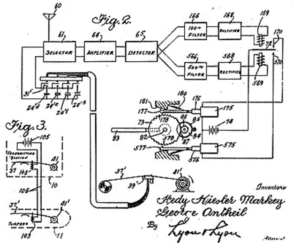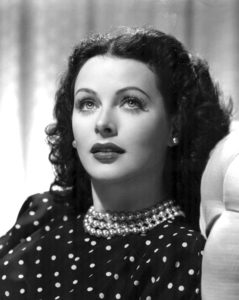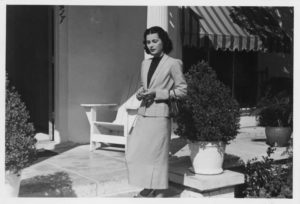
Inspiring Inventor
As a girl, she loved to learn how machines worked and dreamed of being an actress. She convinced her parents to send her to acting school and starred in a number of films and plays in Europe. Eventually, she escaped to America, where she became one of the most famous actresses of all time. She was also an inventor, however, and designed a system of “frequency hopping” that is the basis of our cell phones and wi-fi today. Step onto the stage in 1940 and meet Hedy Lamarr …
Her Ruby Shoe Moment
The Power of the Wand
Her Yellow Brick Road
Brains, Heart & Courage
Glinda’s Gallery
Just the Facts
Her Ruby Shoe Moment
Hedy Lamarr stared down at her inventors table, lost in thought. It was summer of 1940 and she had just gotten home from a dinner party in Hollywood. She spent the entire dinner talking with a musical composer named George Antheil. He wrote Le Ballet Mecanique, which featured a number of mechanical player pianos. After the meal, Hedy and George played a duet on the piano. It evolved into a musical “follow the leader,” with George playing a tune and Hedy picking it up. Hedy couldn’t stop thinking about their duet, and how it might apply to her current project.
For months, Hedy had been tinkering with some ideas for improving the communication systems on Allied ships, so they could better defend themselves from the German U-boats. The Allied forces struggled with their radio communications on ships — U-boats regularly jammed their signals. As a result, ships couldn’t communicate with each other to warn of a U-boat sighting. Even more, ships couldn’t control the torpedoes that were fired at U-boats.

Hedy Lamarr and George Antheils Patent Application
Then, the unthinkable happened. On September 30, 1940, a German U-boat sank the SS City of Benares. The ship was bound for Canada from England and carried refugee children escaping the Blitz. Hedy was horrified and heartbroken. And furious. A tragedy like the SS City of Benares could never happen again.
Hedy knew there must be a way to prevent Allied radio communications from being intercepted or jammed by the Germans. Finally, it hit her. Hedy realized that she could use the duet as a model for ship communication. If two ships could communicate via radio by constantly changing frequencies at a predetermined time, it would be practically impossible to jam the signal. She finally knew what to do, but needed help with the specifics. So she called George.
Hedy and George spent hours and hours working on her idea. They needed to figure out how both sides of a radio transmission could synchronize the switching to different frequencies. It had to be automatic and preprogrammed, like the perforated ribbons of the mechanical pianos. If a sender and receiver had the same “ribbon,” they could automatically change to new frequencies at the same time. They called “frequency hopping.”
 While Hedy designed the system, George created a model. He built a piano ribbon that synchronized 16 mechanical pianos to change among 88 frequencies. When it was ready, they submitted a description of their system, as well as the model, to the National Inventor’s Council. They hoped the Navy would consider their invention for military use. After months, they finally heard back — the Navy rejected it.
While Hedy designed the system, George created a model. He built a piano ribbon that synchronized 16 mechanical pianos to change among 88 frequencies. When it was ready, they submitted a description of their system, as well as the model, to the National Inventor’s Council. They hoped the Navy would consider their invention for military use. After months, they finally heard back — the Navy rejected it.
Hedy traveled to Washington DC to talk to Navy officials in person. But they told her to “stick to her films.” And then they asked her to help sell war bonds. So she did. Hedy performed in 16 cities over 10 days and raised $25 million in war bonds. But she never gave up on her invention.
Hedy and George filed a patent application on June 10, 1941 for their “synchronized alternating radio frequency device.” Patent No. 2,292,387 was approved on August 11, 1942. They donated their patent to the US Navy, which classified it as top secret. Years later, however, the Navy gave it to a military contractor to develop — by the time of the Cuban Missile Crisis of 1962, all the US Navy ships were armed with torpedoes that were guided by Hedy’s invention.
The Power of the Wand
Hedy Lamarr has been called “the Mother of Wi-Fi.” Her patent laid the foundation for Wi-Fi, GPS and Bluetooth technologies that we all use countless times each day. It patent expired in 1959, however, and neither Hedy nor George received any recognition for their invention. Today, the “frequency hopping” technology is estimated to be worth over $30 billion.
Her Yellow Brick Road
In 1937, Hedy knew it was time to escape Austria. It was becoming a dangerous place for people of Jewish heritage. And her husband was more controlling than ever. So she watched and waited and planned. She hired a maid that looked like her and learned her mannerisms. She memorized the schedules and habits of the staff at the chateau. And she acted frail and forgetful at times.
 One evening, Hedy put her plan into action. She claimed to have a headache and skipped dinner. When her maid arrived, Hedy asked her to sit and keep her company. Then, she drugged the maid with sleeping pills, took her uniform, grabbed some jewelry, walked out the service entrance to the chateau, and rode the maid’s bicycle to the train station. Hedy bought a ticket to Paris, then crossed the English Channel to London. She was finally free.
One evening, Hedy put her plan into action. She claimed to have a headache and skipped dinner. When her maid arrived, Hedy asked her to sit and keep her company. Then, she drugged the maid with sleeping pills, took her uniform, grabbed some jewelry, walked out the service entrance to the chateau, and rode the maid’s bicycle to the train station. Hedy bought a ticket to Paris, then crossed the English Channel to London. She was finally free.
When Hedy arrived in London, the first thing she did was obtain a divorce. The second thing she did was to look for work as an actress again. She heard that Louis Mayer, the president of MGM Studios was in town and sprang into action. She lingered in his hotel lobby until they finally met. Mayer offered Hedy a contract with MGM, but she turned him down because the pay was so low. Later, she regretted her decision and wanted another chance.
Hedy learned the Mayer was returning to America on the ship, Normandy. She tried to book passage but it was sold out. So she pretended to be the governess of a young musician to get on board. During the voyage across the Atlantic, she convinced Mayer that she deserved a chance in Hollywood and was worth top dollar. He offered her a 7 year contract, at $500 per week (which was a ton of money back then). And she took it.

Hedy Lamarr (Harry S Truman Library, National Archives)
Hedy changed her surname to “Lamarr” and embraced her new life in America. She watched films over and over to learn the American nuances of the English language, as well as American mannerisms. And her acting career took off. She made over a dozen movies and was one of the biggest film stars of the era. Many called her the “world’s most beautiful woman.” In fact, legend says that Disney’s character Snow White was created in her image.
Hedy dated Howard Hughes for a while — they were attracted to the other’s interest in innovation and technology. Hughes gave her tours of his airplane factories and showed her how the planes were designed and built. He provided her with scientific equipment and supplies so she could tinker with experiments. And he asked her to help redesign his airplanes to make them faster. Hedy immersed herself in the projects, buying books of birds and fish and teaching herself anatomy and aerodynamics. She sketched a new design for airplane wings that combined various features of fish fins and bird wings.
Once World War II began in Europe, Hedy meticulously recreated her time in Austria. She wrote every detail from the dinner parties she hosted and meetings she secretly overheard. She documented the various guests and their conversations about the military and weapons. In particular, Hedy remembered discussions about how best to protect German u-boats from attack. Hedy was determined to put all that information to good use.
Brains, Heart & Courage
Hedy Keisler grew up in Vienna, Austria as the only child of a prosperous Jewish family. Her dad was a banker and her mom was a concert pianist. She had a special relationship with her Dad, who encouraged her to be curious about anything and everything. He told her about the inner workings of machines such as the printing press or streetcars. In fact, Hedy took apart her music box when she was 5 years old — she wanted to figure out how it worked, then put it back together.
Throughout her childhood, Hedy was educated by a private tutor. She also took ballet and piano lessons and learned 4 languages. But her real love was acting. So she convinced her parents to let her attend acting school when she was 16 years old. Her mother disapproved of her decision to become an actress, however, which impacted their relationship for years.
 While performing on stage in Vienna, Hedy caught the eye of Frederick Mandl, a rich and powerful weapons manufacturer. He sat in the same seat to watch her performance night after night after night. Before long, he proposed marriage. And she wasn’t in the position to turn him down. Even more, her father was concerned about what could be coming for the Jewish population in Austria and hoped the marriage would protect their family.
While performing on stage in Vienna, Hedy caught the eye of Frederick Mandl, a rich and powerful weapons manufacturer. He sat in the same seat to watch her performance night after night after night. Before long, he proposed marriage. And she wasn’t in the position to turn him down. Even more, her father was concerned about what could be coming for the Jewish population in Austria and hoped the marriage would protect their family.
When they married in 1934, Mandl required Hedy to convert to Catholicism and give up acting. She figured it a small price to pay to protect her family — he was wealthy, was powerful, and had luxuries such as mansions, hunting lodges, cars and servants. But he was also controlling, jealous, and quick to anger. They lived in a country chateau, Schloss Schwarzenau, and Mandl dictated every aspect of her life. She wasn’t allowed outside the chateau without his approval. She lived in a gilded cage.
Hedy drew upon her acting skills to get through the days. She played the part of a perfect wife and gracious hostess. Many evenings, it worked to her advantage. She and Mandl regularly hosted dinner parties for his business partners, including Nazi officials, fascists, and even Mussolini. Hedy listened to them discuss sensitive matters such as weapon designs, manufacturing, and problems with technology. No one expected Hedy to understand the conversations — she was just an adornment like a precious jewel or priceless painting. But Hedy listened to all that was said at those dinners. She also spied on private meetings that took place in Mandl’s office. And she remembered everything.
Glinda’s Gallery
Just the Facts
- Hedwig Eva Maria Kiesler was born on November 9, 1914 in Vienna, Austria. She studied with a tutor at home, then went to finishing school and eventually acting school.
- Hedy’s film debut was Money on the Street in 1930. Her big break was a role in the controversial film, Ecstasy, in 1932 — her performance brought enough international notoriety that she was able to obtain a film contract in America after she escaped Austria.
- Hedy was married 5 times. In October 1939, Hedy and her second husband adopted an 8 month old Jewish baby who was a refugee from Europe. They named him John. Hedy went on to have 2 biological children with her third husband. Their names were X and X.
- Hedy became a naturalized US citizen in 1953.
- Hedy helped her mother escape from Austria, traveling to London then to Canada and eventually to California.
- Hedy starred in many films during Hollywood’s Golden Age, including Algiers (1938), Lady of the Tropics (1939), Boom Town (1940), Come Live With Me (1941), White Cargo (1942), Tortilla Flat (1942), and Sampson and Delilah (1949). ZIEGFELD GIRL. Her work earned her a star on the Hollywood Hall of Fame.
- After retiring from films, Hedy struggled. She was addicted to “pep pills,” was arrested twice for shoplifting, and lived her last days as a recluse. She continued to tinker with her various inventions for the rest of her life.
- Electronic Frontier Foundation awarded Hedy and George the Pioneer Award in 1997. She also received the Invention Convention’s Bulbie Gnass Spirit of Achievement Award, and was inducted into the National Inventors Hall of Fame.
- Hedy Lamarr died on January 19, 2000 in Orlando, Florida at age 85 from heart disease.
Want to Know More?
“Actress Hedy Lamarr patents the basis for WiFi.” Jewish Women’s Archive (https://jwa.org/thisweek/aug/11/1942/actress-hedy-lamarr-patents-basis-for-wifi).
“Highlighting the Legacy of Hedy Lamarr.” National Inventors Hall of Fame (https://www.invent.org/blog/inventors/hedy-lamarr).
George, Alice. “Thank This World War II-Era Film Star for Your Wi-Fi,” Smithsonian Magazine, April 4, 2019 (https://www.smithsonianmag.com/smithsonian-institution/thank-world-war-ii-era-film-star-your-wi-fi-180971584/).
Rhodes, Richard. Hedy’s Folly: The Life and Breakthrough Inventions of Hedy Lamarr, the Most Beautiful Woman in the World. New York: Vintage Press, 2012.
Shearer, Stephen. Beautiful: The life of Hedy Lamar. New York: St. Martins Press, 2010.
Benedict, Marie. The Only Woman in the Room. Naperville, NY: Sourcebooks Landmark, 2019. NOTE: this is a historical novel and not to be considered a source.
Bombshell: The Hedy Lamar Story. Reframed Pictures, 2017.
